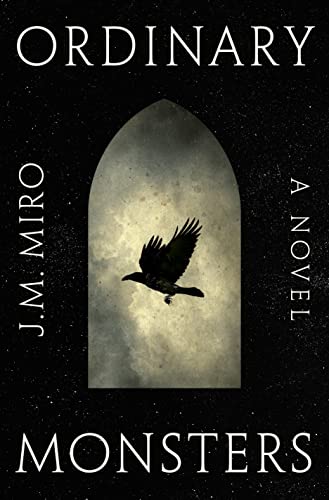With the news lately and the general condition of the world, I don’t think it’s any surprise to see the argument in fiction that the monsters are us. J. M. Miro, whose fantasy debut Ordinary Monsters is out on June 7, has his share of concern and pessimism about the world, but his story about a ragtag bunch of children with powers is ultimately a hopeful one.
Ordinary Monsters features an ensemble cast of characters, all of whom are connected to the secret Scottish estate Carindale. Its owner, Dr. Henry Berghast, sends out his agents to collect the Talents and bring them to him for their own protection. But the estate, shrouded in gloom and haunted by a violent crime a decade earlier, is not so safe as its protectors claim. The wards are failing, and the children of Cairndale don’t know enough about themselves or the world to defend themselves. At first.

Into this tense detante comes a pair of would-be brothers, Charlie and Marlowe. Charlie is a Black boy from the American South whose treatment at the hands of White law enforcement is as brutal as it is familiar. Jim Crow has stolen Charlie’s life quite literally: the sheriff tried to kill him, but he wouldn’t stay dead. He heals from gunshots and beatings, but the pain lingers, and he doesn’t know if Cairndale will be a haven or more of the same. On his way there he meets Marlowe, a younger White boy being pursued by some of the same monsters.
Marlowe is a foundling adopted by a series of mothers who know of his strange power to glow and to heal. But they keep him close and stay on the run, knowing that the world will not understand him. Marlowe and Charlie unite out of desperation but slowly become real friends, opening up to each other and to some of the other kids at Cairndale.
The children—the Talents—come from all over the world, but their powers have universal and specific bounds. They can only work their magic upon dead matter, and they are further limited in the subject of their workings. Charlie can only work his magic on his own body, but he can heal from every wound save decapitation. Komako can manipulate the dead cells all around, pulling the dust to her and then shaping it to her purposes. Others can become very dense or tall, can turn invisible, or can create golems of flesh or bone. Some of these powers are a bit thin on their connection to death, but Miro isn’t trying to Sanderson it. He wants a ragtag team of tragic, powerful kids to save the world, and I’m willing to suspend some disbelief to go along with his vision, which is as effective a Gaslamp fantasy as I’ve read. It’s as if the X-Men were given only powers related to death, and then sent to Victorian England to be part of a very special school headed by a singularly driven man. Or, it’s like Sabriel, with its dead who refuse to stay dead. There are also elements of Miss Peregrine’s Home for Peculiar Children, and the League of Extraordinary Gentlemen.
There are a lot of likes, but Ordinary Monsters is ultimately only itself. And there’s a lot to like about it. The prose is compelling with a dreamy tendency, elaborating on details and then skipping over transitions to insist only on the most important parts. Miro likewise writes emotional and situational complexity with a light, deft touch. He never over-explains, which washes his landscapes with eerie ambiguity. Is there a threat? Is it from without, or from within? We’re asked to keep track of many half-truths and lies and sort them out ourselves, just as Charlie, Marlowe, and everyone else must try to do.
What Worked: the atmosphere, the characters, the prose
What didn’t: magic system not entirely coherent, bit too long
Ideal reader: X-Men fans, steampunk aficionados, anyone who wants an epic read
The villains are credibly sympathetic and uncomfortably maddened by the burdens placed upon them. There is no one to hate, but many to dread. Jacob Marber seems a force of nature, but his tragic past and his deep well of feeling do not entirely square with the picture of evil that others paint. Equally and opposite, the nobility of Henry Berghast, who has put his fortune and position entirely in the service of uniting and educating Talents, is tarnished by a cool ends-justify-the-means obsession with saving the world. Heroism and compassion are fascinatingly at odds within Ordinary Monsters, and Miro is certainly asking deep questions about how we can reconcile ourselves to grief for the dead and the terrible trials of living.
Miro doles out secrets in a steady breadcrumb trail, tidbits that always leave you hungry for more. The revelations are never twists; there is always a patient scaffolding of rumor and detail going up for every big reveal, so that everything feels perfectly believable. The ending left me with many questions, but so many others were answered that it didn’t feel like a cheat. It just made me eager for more.
This book stands very much on the shoulders of giants, its many predecessors in fantasy, comics, and Victorian settings. That’s actually all to the good. Miro is clearly aware of convention and carves out his own little niche, in conversation with plenty of other books and able to bring plenty of artistry to that conversation. It’s a solid read, engaging from start to finish, and well-written to boot. I will be extremely pleased to keep reading, and I look forward to the next installment.
